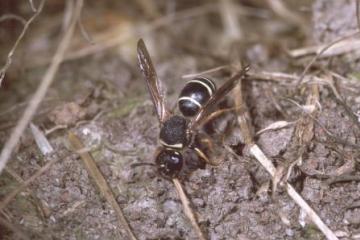Species Account for Odynerus simillimus
Odynerus simillimus Morawitz, F., 1867
Fen Mason-wasp
Aculeata: Eumenidae

Reproduction for study and non-profit use permitted, all other rights reserved.
Taxonomic group: bees and wasps (Aculeata) - County data
View time series maps for Odynerus simillimus
member log-on for taxon report
Status: RDB 1;Section 41 Priority Species
Essex RDB: Listed
Threat: Essex Endangered
Images
upload a new image
Species text
Odynerus simillimus was considered extinct in Britain until its rediscovery in 1986 in Norfolk. It is listed as Extinct (RDB1+) in Shirt (1987), but Falk (1991) provisionally places it in the Endangered (pRDB1) category. It is an extremely rare medium-sized whitish-yellow and black Eumenine wasp known from very few British or European specimens. The species has been associated with coastal grazing marsh and fens (Archer 2000), but the most recent discoveries suggest that in Britain the coastal association may be especially significant. Nesting aggregations of Odynerus simillimus were discovered in August 2000 by David Scott (Harvey & Scott 2001) at Alresford, North Essex, and due to the international importance of the British populations the species was added to the Species Recovery Programme and was subject to autecological research (Harvey 2001, 2002) between 2001 and 2003.
It is a burrower that is stated by Falk (1991) to nest in the ground or in vertical banks of earth, old walls, etc. and to probably provision its nest cells with small lepidopterous caterpillars or the larvae of curculionid beetles. Work during 2001-2002 found the prey to be Hypera weevil larvae, and this was confirmed in 2003 as Hypera pollux, a weevil feeding on Fool's Water-cress Apium nodiflorum and Lesser Water-parsnip Berula erecta (Scott 2004). Nesting takes place in level to vertical clay exposures even where these are amongst open sea couch stems. However in 2002 nesting was observed in the corner of an arable field edge on soil turned the previous autumn near one of the Alresford aggregations, and another aggregation, the largest found in Essex, was discovered on bare silty clay at the side of a new borrowdyke at Brightlingsea, built about four or five years previously as part of new sea defences (Scott 2003), suggesting that the wasp will utilise recently disturbed soil. Large aggregations were found in 2002 at Hickling Broad on old ditch dredgings, and a very few nests were found at Shoebury in South Essex on upturned tree boles in a Phragmites marsh, where satellite images now clearly indicate that the habitat has been destroyed, despite the wasp's presence and importance being documented and known to the local authority. References
Habitats
Why not join the Club, register and add a new species page
Interpretation of distribution maps



















